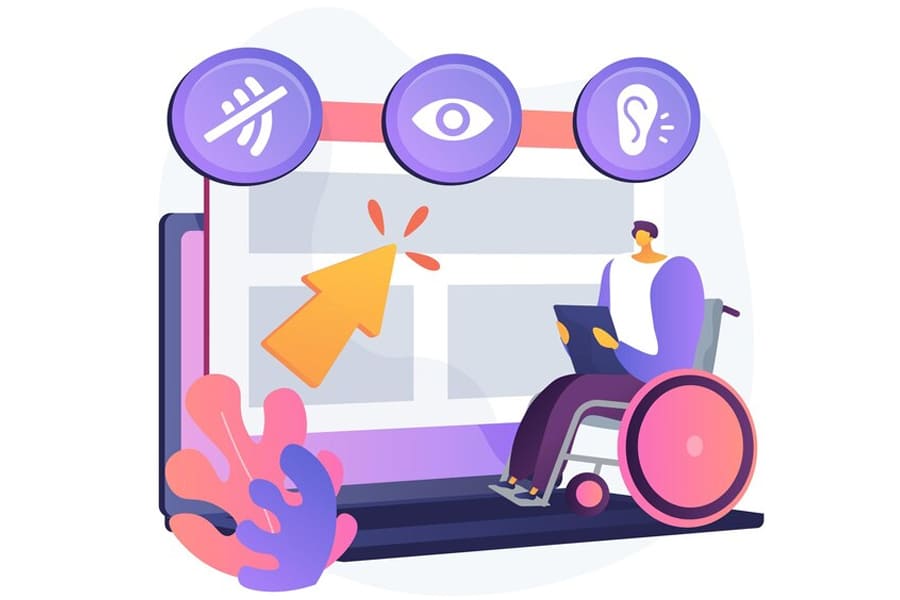
How can you make your website accessible to anyone? Most website owners don’t think about that. According to Accessibly, about 96% of the world’s top web pages had clear accessibility failures.
This is not just irresponsible but also a significant business oversight, as 16% of the world’s population has some disability, which translates to nearly 1.3 billion individuals. They may need assistive tools and technologies to access online content.
You may be neglecting millions of potential visitors to your website. Whether you’re a website developer, an e-commerce retail business, or a personal brand, an accessible website is a must.
This article will tell you everything you need to know about web accessibility: what it is, how it will help your business, and practical tips on implementing it.
Understanding Web Accessibility: Importance and Benefits
Web accessibility ensures that websites provide equal access to all users, especially those with disabilities. For e-commerce business owners, optimizing for accessibility should not just be a trend but a strategic commitment.
In the US alone, 27% of adults live with a disability. In the Philippines, this number is 12% of Filipinos aged 15 and older. These numbers represent millions – a considerable consumer base you shouldn’t overlook. Yet, most businesses seem to be doing just that.
According to a 2019 Nucleus research, 70% of internet sites are inaccessible to blind people (just one segment of the differently-abled sector). And this is already costing retailers $6.9 billion every year.
Your site’s web accessibility has now become critical for your success. The good thing is, there’s no better time to make your website accessible.
Web Content Accessibility Guidelines (WCAG): Overview and Compliance

The Web Content Accessibility Guidelines (WCAG) are global standards that detail specific guidelines for making websites, apps, electronic documents, and other digital assets more accessible.
It was created by an international body called the World Wide Web Consortium (W3C) and has many other components like the WAI-ARIA (WAI specification for Accessible Rich Internet Applications) for dynamic content and more.
The WCAG is conceptualized for flexibility and adaptability to new technologies and web design practices.
It includes the following key features:
- Guidelines: Web content developers and other parties who want or need a standard for web accessibility can find a comprehensive list on WCAG.
- Success criteria: For each guideline, there are three levels of testable success criteria (A, AA, and AAA). These criteria help with assessing accessibility for websites or digital assets.
- Techniques and resources: The WCAG offers techniques, resources, and tools for anyone who wants to make their websites accessible.
- Education and training: The WCAG also provides education resources and training materials to help everyone understand and implement the guidelines.
Compliance with WCAG is not a legal requirement, although they’ve been adopted by many government institutions, even in the Philippines.
For business owners, the WCAG also holds the key to untapped opportunities. Compliance with the WCAG means equal access, meaning your websites experience increased user engagement and expanded customer reach.
On the contrary, non-compliance might even lead to legal complications and loss of potential customers.
Top 13 Tips for Website Accessibility
You need to make your website accessible, but how do you do it? This section will be the only reference point you need to improve website accessibility.

Text Alternatives for Non-Text Content
Text alternatives are lifelines for users with various disabilities, such as visual impairments, auditory impairments, or cognitive disabilities.
The previously-mentioned Nucleus research highlights the importance of text alternatives.
To address this, you can implement a couple of things:
- Use descriptive alternative text (alt text) or descriptions for images: Provide concise and meaningful alt-tag equivalents for images, video files, and other multimedia to convey the purpose and context of the image.
- Include text-based output for multimedia: When it comes to multimedia, accessible videos and audio, and other multimedia elements, make sure to provide captions and additional text-based output as an alternative for people with auditory impairments, deaf users, or other disabilities.
- Provide accessible versions of PDFs and other documents: Ensure that all PDFs and other documents are accessible by implementing text alternatives for non-text content, such as images or charts.
- Use an accessible multimedia player: When unavoidable, use a player with accessibility features like captions, audio descriptions, easily identifiable and navigable controls, and supports alternative formats.
Without an accessible alternative to non-text or visual elements, people with disabilities (primarily visual impairments) can’t receive information, complete transactions, and access services.
Structuring Content with Proper Headings and Semantic Markup
Heading and semantic markups are organizational tools that structure content.
Headings act as signposts, guiding users through information hierarchies, while semantic markups convey the meaning of specific content elements.
This means that structuring content with proper headings and semantic markup will ensure that your content is organized, logical, and easily navigable for users, even those using assistive technologies.
To implement improvements for your website, you can take the following actionable steps:
- Use appropriate heading tags: Use HTML header tags (H1 through H6) to identify headings and subheadings in a logical hierarchy.
- Identify page sections and landmarks: Use ARIA landmark roles (a W3C concept that helps with page description) to identify the start of content areas on a page, such as main content, navigation menus, or page footers.
- Markup lists: Use markup for different lists, such as unordered lists (ul and li) for lists without logical order, ordered lists (ol and li) for sequential information, and definition lists for key/value pairs.
- Mark up data tables: Use table markup with tr elements for tabular data like table rows and td elements for data cells, along with the th element to identify row and column headers.
Last but not least, separate content and presentation. Ensure that HTML elements are used according to their intended purpose and that CSS applies styling separately.
Color Contrast and Color Accessibility: Ensuring Readability
Website color contrast is one of the most pervasive accessibility issues for many websites.
WebAIM’s 2023 report studied 1 million websites and found that bad contrast is the most common accessibility failure, with 86.3% of the surveyed websites failing the assessment.
People with regular vision don’t think about it, but for the 16% of the world’s population with some form of vision impairment, low color contrast leads to terrible experiences, even on screen readers.
Here’s how you can improve color contrast and enhance color accessibility for people with vision impairments:
- Ensure sufficient contrast: Ensure the difference between text and background meets accessibility standards, with a color contrast ratio of at least 4.5:1 for small text and 3:1 for large text.
- Test color combinations: Use tools like WebAIM’s Color Contrast Checker or Contrast Grid to test your color palette for accessible combinations.
- Avoid overreliance on color: Don’t use color alone to convey meaning; use meaningful icons, words, and other visual elements to get the content.
- Temper stark contrast: Avoid using black text on a completely white background when possible. Stark contrast presents accessibility issues to people with visual conditions, such as blurred or moving text.
Also, you may use accessible text over images. When using text over images, use a solid background behind the text or at least a dark overlay to the image to avoid stark contrast.
Keyboard Accessibility: Navigating and Interacting without a Mouse

Keyboard accessibility means disabled people can fully operate your website using a keyboard, along with each web page on it.
Keyboard-only navigation is critical for people who can’t use a mouse, particularly people with motor disabilities. Those who rely on assistive technology will also greatly benefit from keyboard navigation – many of these technologies aren’t made to be used with a mouse.
Fortunately, a website owner can do plenty of things to address this issue:
- Ensure keyboard navigation: Ensure all interactive elements (links, buttons, and form fields) are keyboard-activated. They should also clearly indicate when they can be activated with the keyboard.
- Test keyboard navigation: Test your website for keyboard navigation compatibility using automated tools or manually navigating the website using only the keyboard.
- Avoid keyboard traps: Ensure the keyboard focus is not trapped in any part of your website, allowing users to navigate freely.
- Provide keyboard shortcuts: Provide keyboard shortcuts for frequently used actions, such as submitting a form or navigating to a specific page.
In addition to the above advice, use ARIA roles. They will help you identify the start of content areas on a page, such as main content, navigation menus, or page footers, making it easier for users to navigate.
Focus Indicators and Focus Management: Assisting Keyboard Navigation
Focus indicators are those visible cues showing which element on a webpage currently has keyboard focus. These cues can be outlined in elements, highlighted colors on anchor text, or other signs.
Managing this specific element is called focus management – ensuring that your website and its content allow for a smooth flow of focus throughout all its elements.
This is another aspect of keyboard navigation – without proper focus management on a website, keyboard-only users can quickly feel lost, resulting in a terrible experience.
For e-commerce, this translates into frustrated customers.
You should improve your website’s focus management through the following tips:
- Logical focus order: Arrange your essential components in an order that preserves meaning and operability. This will make it easier for users to navigate and understand the content, even with only keyboards.
- Clear focus indicators: Provide clear focus indicators for interactive elements, such as a blue outline, highlighted color system, or other visual cues. This will assist users in identifying which element currently has focus.
Without clear focus indicators, users might struggle to look for items, complete purchases, or access your services.
Assistive Technologies: Compatibility and Testing
Assistive technologies are digital aids designed to make online experiences accessible. Specifically, these can be readers, speech recognition software, or screen magnifiers.
They are tools that let different-abled or disabled users navigate the digital world. Your ecommerce platform must seamlessly work with these assistive technologies, but to do that, you must be vigilant with testing.
Here are some tips to ensure compatibility:
- Conduct regular audits: Periodically assess your platform’s compatibility to catch and address any issues promptly.
- Utilize assistive technology documentation: Refer to guidelines provided by assistive technology vendors.
- Contact professionals to ensure smooth integration: Accessibility technology vendors and web development experts can create a smooth, error-free integration to ensure your website is fully compatible.
- Incorporate results of user testing into your design: Engage users with disabilities to test your platform.
Compatibility is key when it comes to assistive technology integration.
Accessible Forms: Labeling, Validation, and Error Handling
Online forms are part and parcel of the digital world. Whether you’re submitting complaints, filing orders, or filling in information for services, forms are an unavoidable part of online. Thus, websites need to have accessible forms.
Here are a few tips:
- Labeling: Label form fields for easy understanding.
- Validation: Ensure users receive prompt and clear feedback on the information they provide.
- Error handling: Guide users to correct any mistakes without frustration.
For e-commerce, inclusive forms translate into smoother transactions, meaning increased completion rates and enhanced overall user experience.
Clear and Simple Language: Writing for Clarity and Comprehension
Good web writing ensures that all users easily understand your website’s content.
Follow the following digital writing best practices:
- Be simple and direct: Use clear, straightforward language, avoiding unnecessary jargon.
- Prioritize quality over quantity: Opt for concise sentences to keep readers engaged.
- Be action-oriented: Craft actionable content, guiding readers on the next steps.
- Optimize for scannability: Break content into digestible chunks with headings, bullet points, and short paragraphs.
- Prioritize readability: Prioritize readability with proper headings, alt text, and an inclusive tone for a universally welcoming online space.
Simplicity and clarity are crucial in aiding audiences of all abilities to make informed decisions, reduce confusion, and ensure a smooth website experience. In e-commerce, especially, this clarity is crucial – potential customers will immediately opt-out if your website is confusing.
Navigation and Site Structure: Consistency and Ease of Use
An intuitive and easy-to-use site structure is the backbone of user-friendly navigation. When you make your website with a well-designed architecture, users can interact and navigate through your content effectively, regardless of their abilities.
For e-commerce businesses, this means quicker transactions, lesser frustration and cart abandonment, and a happier customer base.
Here are some tips you can easily implement:
- Use consistent design elements: Unified design elements, such as color schemes, fonts, layouts, and navigation menus, create an intuitive experience for everyone.
- Maintain consistent navigation: Navigation menus and links must have consistent placement and mechanics across all website pages to make it easier for users to navigate and understand the content.
- Use clear and concise language: Avoid jargon or complex terminology that might be difficult for some users to understand and provide descriptive URLs.
- Test for consistency and ease of use: Schedule a regular testing schedule with automated tools or manual navigation to ensure all users can navigate and interact with the content effectively.
Also, provide feedback and help. This can include error messages or tooltips, to guide users and help them understand how to interact with the content.
Accessibility Testing and Evaluation: Tools and Techniques
Accessibility testing and evaluation mean systematically checking your website to ensure it’s user-friendly for everyone – a thorough check-up to ensure everything is in shape.
Proper testing identifies and resolves issues before they affect users. For e-commerce websites, you won’t lose sales and leads because your site suddenly went down or developed a bug that prevented integration with accessibility technologies.
Here are some best practices for testing and evaluation:
- Use automated testing tools: There are automated online tools that you can use to test your website, saving time and resources quickly. Some of the most popular include WAVE, Siteimprove, and Google Lighthouse.
- Perform manual testing: While automated tools are more efficient, manual testing is still necessary for identifying issues that automated tools may miss, such as context issues, content quality, and user experience.
- Set a regular testing schedule: Regular testing will ensure new content or updates don’t introduce new accessibility issues. Moreover, you should continually test at different stages of development, including during design, development, and post-launch.
- Involve accessibility experts: Accessibility experts can provide valuable insights and guidance on accessibility best practices and standards.
Last but not least, track and document findings. Keep a record of all your accessibility findings to ensure that accessibility is prioritized and maintained over time.
Accessibility Policy and Statement: Communicating Commitment to Accessibility
An Accessibility Policy and Statement is an explicit declaration by a company outlining its commitment to ensuring equal access to its digital platforms for everyone, regardless of ability.
Explicitly stating your commitment to accessibility signals a customer-centric approach. It demonstrates social responsibility and reflects positively on the company’s values. All of these combine to build customer trust and loyalty.
More than that, an accessibility policy and statement might be required by your country to operate.
User Feedback and Continuous Improvement in Web Accessibility
User feedback is crucial for pinpointing accessibility obstacles, safeguarding web content accessibility over time, and showcasing your company’s commitment to accessibility.
Thus, implement the following tips:
- Create an Accessibility Statement: Outlines your business’s commitment to accessibility, including its policies, content management system procedures, and accessibility goals.
- Include accessibility information on the website: Link to your accessibility statement, contact information for accessibility inquiries, and provide instructions for using assistive technologies.
- Train employees on accessibility: Regularly train your employees on best practices and standards and how to implement them in their work.
- Partner with accessibility organizations: Reach out to local organizations or hire accessibility consultants to provide guidance and support on accessibility initiatives
Also, engage with the right communities. Engage with communities that value accessibility and inclusivity. Attend conferences, participate in forums, partner with them for marketing, and reach out through social media.
Final Thoughts

Whether based in the Philippines, in the Western world, or anywhere else, you must implement accessibility best practices into everything you do for your business.
Creating a website with accessibility at its core is not just a compliance measure but a strategic move with benefits beyond sales: improved customer relationships, strong brand loyalty, and making a real difference for people interacting with the world differently.Implementing accessibility features is complicated at first, but with this complete guide, a fully accessible website is in your grasp.
Frequently Asked Questions
Why is web accessibility important for my online e-commerce business?
Web accessibility ensures your digital space is inclusive, reaching as many visitors as possible and improving overall user experience.
How can I quickly enhance my website’s accessibility?
The first step you must take is to gather knowledge through the complete guide above. Then, accomplish accessibility quick wins by using clear language, ensuring high color contrast, providing a descriptive alt attribute for multimedia elements, and adding video and audio file transcripts.
Does making your website accessible have any business impacts?
Web accessibility positively affects user satisfaction, brand reputation, and potential customer reach. Perfecting site accessibility leads to increased conversion rates and business growth.